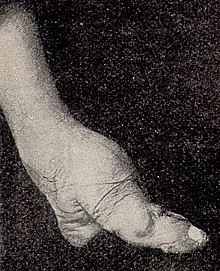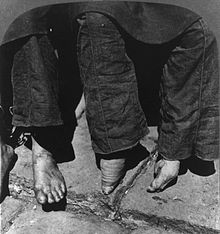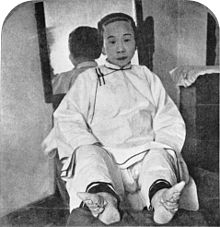Tying your feet
The tying of the feet was a custom of body modification that was widespread in China until the 20th century , in which the feet of little girls were irreparably deformed by breaking bones and then tying them to an extreme degree. Background was probably as early as the 10th century existing beauty ideal for the woman's foot, the lotus or Lilienfuß was called. The goal was small feet of about 10 centimeters, which, tied in individually made and decorated silk shoes, stand for the beauty and domesticity of women and at the same time should change their gait.
Above all, girls from higher-ranking families were victims of this custom in mostly early childhood, which caused serious damage to health and as a result hindered movement or made it possible only with massive pain.
Banned as early as 1911 and partly continued in secret, tying the feet was finally outlawed in 1949 by Mao Zedong's legally anchored ban.
Background and origin of foot binding
The custom of tying the feet is said to go back to a lover of Li Houzhu , the last ruler (ruled 961–976) of the Southern Tang Empire . This dancer bandaged her feet in a shape that resembled a hoof in order to be able to perform on the golden, lotus flower-shaped stage that the emperor had built for her. Yu Huai , a 17th century Chinese historian, traced the root of the foot binding and found the following:
“In ancient times, there was no difference between men's and women's feet… My research has shown that foot binding began to become fashionable at the time of Li Houzhu's Southern Tang Dynasty. He had a royal servant named Yao Niang, who became famous for her delicate beauty and her talent for dancing. So he had a golden lotus flower made six feet high and adorned with precious stones, garlands, and silk tassels. This golden lotus blossom, glowing in many colors, stood in the middle of the hall. Yao Niang now had to snuggle into this flower with his feet tied with silk ribbons and imitate the shape of the crescent moon. She danced on the lotus flower in her white socks, did pirouettes and gave the impression that the wide sleeves of her robe were clouds. Her style was imitated by many. So Yao Niang was the first to start tying your feet. "
During this time, however, the feet were only loosely bandaged, comparable to the pointe shoe of a ballerina , and there was no mutilation as later. In the Song Dynasty , under the influence of neoconfucianism, women's rights and opportunities were increasingly restricted. From then on it was customary to tie in the feet of girls from the upper classes from early childhood.
The custom spread to all strata of the population by the beginning of the 20th century with the exception of the poorest farmers, who needed women with intact feet to work in the fields. The Mongols , who formed the Yuan dynasty from 1279 to 1368 , and the Manchus , who ruled China from 1644 to 1911, did not follow this custom either. In contrast to the Han Chinese , the Manchurians did not believe in lotus feet, so one could easily recognize Manchuresses by their normally developed feet.
Description of the procedure
Most girls had their feet tied by their mother or grandmother when they were five to eight years old. The prerequisite was that the child had reached the "age of reason" and was accessible to the arguments of the older women. First, the foot was soaked in a liquid made from herbs and alum, the toenails were cut as short as possible to prevent ingrowth and associated infections, and the foot was then massaged. The foot was then wrapped so tightly with bandages that it was inhibited in growth and deformed into a clubfoot . Then the girls were forced to walk with sniffed shoes to improve blood flow to their feet. With the exception of the big toe, all toes were broken and bent under the sole of the foot. The toes of the young girls were tied under the soles of the feet every two days with wet and increasingly narrow bandages, which became even tighter as they dried, so that they had narrow, pointed feet. If the feet were deformed in this way, the women could no longer walk long distances. The broken, constricted club feet often led to complications - ingrown and inflamed toenails, purulent, infected bone splinters, rotten skin, and dead toes.
Social relevance
The ideal foot length for a woman was three “ cun ” (10 cm) - such feet were called “golden lotus” and correspond to shoe size 17. In fact, only a few women reached this length. Most tied feet measured an average of 13 cm to 14 cm. Lifelong pain and physical disabilities were naturally accepted and made young women attractive to men.
It even happened that men no longer paid any attention to their bride's face if only their feet were small, and that women with larger feet were subject to social ostracism. The restricted mobility also made many women plump, which also corresponded to the ideal of beauty at the time. Parents usually viewed tying their feet as a necessary investment in their daughters future.
As a rule, the bandages were perfumed and artfully designed, small special shoes were worn. Bandages and shoes were usually kept on in bed to prevent further growth of the feet and to hide inflammation and putrid smells.
prosperity
Women with lotus feet were usually no longer able to travel long distances without assistance. Over time, the beauty ideal of small feet was combined with the virtue of not leaving the house. The tying of the feet became a common sign of prosperity in the upper classes of the population. It was considered improper for a wealthy woman to leave the house. Wealthy women let themselves be carried in a litter that was curtained on all sides.
Only the daughters of poor agricultural families were usually not tied because they were needed for field work.
eroticism
The small steps of such women were described by Chinese poets and poets as erotic and the small feet were often perceived as the most erotic part of the female body. Allegedly, the helpless movements of these women aroused the "protective instinct" of men. The deformation procedure reduced the woman's ability to move. In addition, she caused triple steps, the erotic charisma of which is similar to that of high heels. In addition, the swaying gait should strengthen the thigh muscles and tighten the vagina.
Submissiveness
While the position of women within the family and marriage during the liberal Tang dynasty was characterized by respect and self-confidence, this role model gradually changed during the subsequent Song dynasty . The fashion of the lotus feet, which was emerging at the same time, favored the increasingly submissive position of women. Due to the severely restricted mobility, women were mostly at home and tied to the household according to their possibilities. They were thus subject to their husbands and, moreover, did not pose a threat to male supremacy. Likewise, according to the circumstances, they were forced to be loyalty.
Abolition of tying the feet
During the late Qing Dynasty ( early 20th century ) and in the Republic of China , it was still customary to tie girls' feet. During industrialization , however, there was an increasing need for labor in order to remain competitive with the USA, Europe and Japan. There were also several social movements that rejected the tying of the feet and were supported, among others, by the women's rights activist Qiu Jin and commented as follows:
“Why do we women put up with sacrificing our lives for two feet whose bones are crushed and whose feet are stunted? (...) The cause lies only with yourself, who consider yourself to be worthless beings and who do not seek to qualify yourself professionally so that you can earn your own living. It is your fault that you always confide in men and that all your energy is devoted to flattering them and finding a thousand new ways in which you can make yourself nice with them. "
The overcoming of the tying of the feet was promoted, among other things, by the establishment of parent groups who promised each other not to break and tie their daughters' feet, nor to marry their sons to women with tied feet. This created collectives with new behavior patterns that were accepted by parents as reference groups.
In some cases, lotus feet as a symbol of traditional China were so massively rejected that feet that were already tied were broken open again.
A decree against tying the feet was issued shortly after the Boxer Rebellion in 1900 by the Dowager Empress Cixi , then repealed, in 1902 it was banned again, each time with limited success. In 1911, foot tying was banned in the Republic of China. However, it continued with a downward trend into the 1930s.
The situation was particularly tough for women during this transition period. Some women who had their feet tied in pain as children have been abandoned by their husbands or have been humiliated by publicly exposing their feet.
After the founding of the People's Republic of China in 1949, the custom was finally banned and outlawed under Mao Zedong , presumably because the government demanded equal rights for women and workers were needed. Women with bound feet faced sanctions. Nowadays this practice has become both prohibited and uncommon. The earlier Chinese women's shoes are no longer produced these days. The last factory that made special shoes for tied feet closed in 1999.
Older women with so-called lotus feet still live in China today. In her photo series Lotoslillies (2000), the artist Beate Passow staged photos of such women wearing splendidly embroidered shoes. In the indirect way of subtle staging, in which the beautiful appearance obscures the harsh reality, an accusation against the oppression of women is expressed here.
literature
- Michael Andritzky (Ed.): E.g. shoes - from bare feet to high heels. A cultural history of footwear 4. AUfl. Anabas, Frankfurt 1998, ISBN 3-87038-138-8 , pp. 210-213
- Dorothy Ko: Cinderella's Sisters: A Revisionist History of Footbinding. University of California Press, Los Angeles 2005 (paperback 2008), ISBN 0-520-25390-6 .
- Gerry Mackie: Ending Footbinding and Infibulation: A Convention account. In: American Sociological Review. Volume 61, 1996, pp. 999-1017
- Beverley Jackson: Splendid Slippers: A Thousand Years of an Erotic Tradition. 10 Ten Speed Press, California 1998, ISBN 978-0898159578 .
Fiction:
- Jung Chang: Wild swans. Three women in China from the imperial era to today. Knaur TB, 2004, ISBN 3-426-62705-1 .
- Kathryn Harrison: The bound feet. Novel. List, Munich 2001, ISBN 3-471-79432-8 .
- Lisa See: The silk fan. Novel. Bertelsmann, Munich 2005, ISBN 3-570-00875-4 .
Web links
- Golden Lotus ( Memento from May 4, 2006 in the Internet Archive )
- Living History 24 , project by photographer Jo Farrell - Portraits of Women with Bound Feet 2014, accessed July 25, 2014
Individual evidence
- ↑ a b Matt Schiavenza: The Peculiar History of Foot Binding in China. In: The Atlantic. September 16, 2013, accessed January 19, 2019 .
- ^ Dorothy Ko: Teachers of the Inner Chambers: Women and Culture in Seventeenth-Century China . Stanford University Press, Stanford 1994, ISBN 978-0-8047-2359-6 , pp. 149 ( limited preview in Google Book search).
- ↑ a b Perverse ideal of beauty ( memento of the original from September 29, 2009 in the Internet Archive ) Info: The archive link was inserted automatically and has not yet been checked. Please check the original and archive link according to the instructions and then remove this notice. Doctors Week Online
- ↑ "Bound Feet" An agonizing tradition: The last women in China with "lotus feet" Brigitte.de
- ↑ Jihong Fu: The image of women in the images of school books in the People's Republic of China and the Republic of China. A content analysis. , Dissertation to obtain the academic degree of Doctor of Philosophy from the University of Hamburg, 1999; P. 49. PDF full text .
- ↑ a b c d Goldener Lotus - The bound feet of women in China ( Memento from October 18, 2007 in the Internet Archive ) Bayerischer Rundfunk - Radio Knowledge
- ↑ https://www1.wdr.de/mediathek/video/sendung/planet-wissen-wdr/video-lotusfuesse--102.html
- ^ Kai Vogelsang : History of China. Stuttgart 2012, p. 484
- ↑ Wolfgang Ullrich: Burkas. In: beate-passow.de. Retrieved May 25, 2017 .










